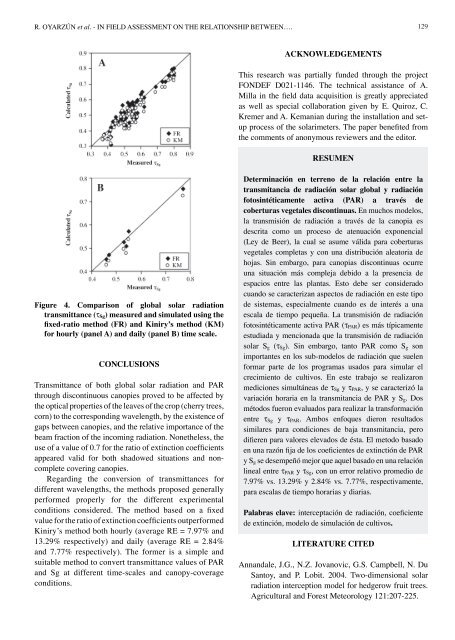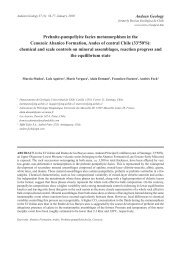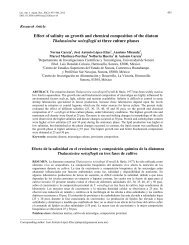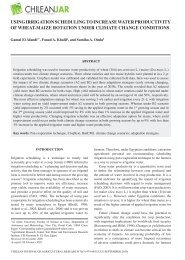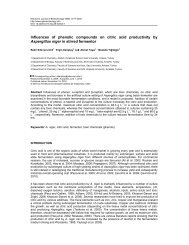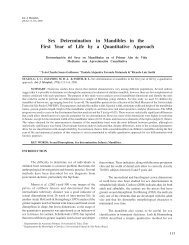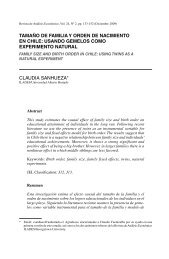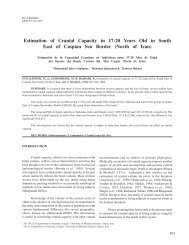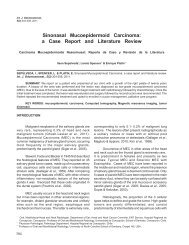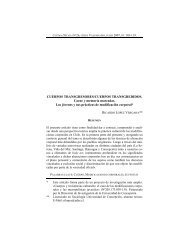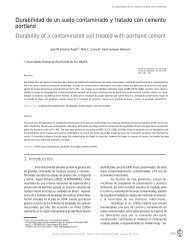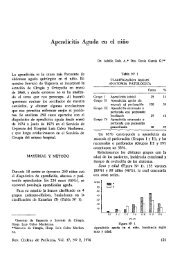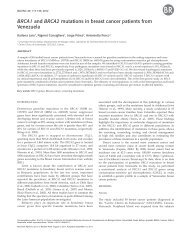(par) and global solar radiation transmittance t
(par) and global solar radiation transmittance t
(par) and global solar radiation transmittance t
You also want an ePaper? Increase the reach of your titles
YUMPU automatically turns print PDFs into web optimized ePapers that Google loves.
R. OYARZÚN et al. - IN FIELD ASSESSMENT ON THE RELATIONSHIP BETWEEN….<br />
129<br />
ACKNOWLEDGEMENTS<br />
This research was <strong>par</strong>tially funded through the project<br />
FONDEF D021-1146. The technical assistance of A.<br />
Milla in the field data acquisition is greatly appreciated<br />
as well as special collaboration given by E. Quiroz, C.<br />
Kremer <strong>and</strong> A. Kemanian during the installation <strong>and</strong> setup<br />
process of the <strong>solar</strong>imeters. The paper benefited from<br />
the comments of anonymous reviewers <strong>and</strong> the editor.<br />
RESUMEN<br />
Figure 4. Com<strong>par</strong>ison of <strong>global</strong> <strong>solar</strong> <strong>radiation</strong><br />
<strong>transmittance</strong> (τ Sg) measured <strong>and</strong> simulated using the<br />
fixed-ratio method (FR) <strong>and</strong> Kiniry’s method (KM)<br />
for hourly (panel A) <strong>and</strong> daily (panel B) time scale.<br />
CONCLUSIONS<br />
Transmittance of both <strong>global</strong> <strong>solar</strong> <strong>radiation</strong> <strong>and</strong> PAR<br />
through discontinuous canopies proved to be affected by<br />
the optical properties of the leaves of the crop (cherry trees,<br />
corn) to the corresponding wavelength, by the existence of<br />
gaps between canopies, <strong>and</strong> the relative importance of the<br />
beam fraction of the incoming <strong>radiation</strong>. Nonetheless, the<br />
use of a value of 0.7 for the ratio of extinction coefficients<br />
appeared valid for both shadowed situations <strong>and</strong> noncomplete<br />
covering canopies.<br />
Regarding the conversion of <strong>transmittance</strong>s for<br />
different wavelengths, the methods proposed generally<br />
performed properly for the different experimental<br />
conditions considered. The method based on a fixed<br />
value for the ratio of extinction coefficients outperformed<br />
Kiniry’s method both hourly (average RE = 7.97% <strong>and</strong><br />
13.29% respectively) <strong>and</strong> daily (average RE = 2.84%<br />
<strong>and</strong> 7.77% respectively). The former is a simple <strong>and</strong><br />
suitable method to convert <strong>transmittance</strong> values of PAR<br />
<strong>and</strong> Sg at different time-scales <strong>and</strong> canopy-coverage<br />
conditions.<br />
Determinación en terreno de la relación entre la<br />
transmitancia de radiación <strong>solar</strong> <strong>global</strong> y radiación<br />
fotosintéticamente activa (PAR) a través de<br />
coberturas vegetales discontinuas. En muchos modelos,<br />
la transmisión de radiación a través de la canopia es<br />
descrita como un proceso de atenuación exponencial<br />
(Ley de Beer), la cual se asume válida <strong>par</strong>a coberturas<br />
vegetales completas y con una distribución aleatoria de<br />
hojas. Sin embargo, <strong>par</strong>a canopias discontinuas ocurre<br />
una situación más compleja debido a la presencia de<br />
espacios entre las plantas. Esto debe ser considerado<br />
cu<strong>and</strong>o se caracterizan aspectos de radiación en este tipo<br />
de sistemas, especialmente cu<strong>and</strong>o es de interés a una<br />
escala de tiempo pequeña. La transmisión de radiación<br />
fotosintéticamente activa PAR (τ PAR) es más típicamente<br />
estudiada y mencionada que la transmisión de radiación<br />
<strong>solar</strong> S g (τ Sg). Sin embargo, tanto PAR como S g son<br />
importantes en los sub-modelos de radiación que suelen<br />
formar <strong>par</strong>te de los programas usados <strong>par</strong>a simular el<br />
crecimiento de cultivos. En este trabajo se realizaron<br />
mediciones simultáneas de τ Sg y τ PAR, y se caracterizó la<br />
variación horaria en la transmitancia de PAR y S g. Dos<br />
métodos fueron evaluados <strong>par</strong>a realizar la transformación<br />
entre τ Sg y τ PAR. Ambos enfoques dieron resultados<br />
similares <strong>par</strong>a condiciones de baja transmitancia, pero<br />
difieren <strong>par</strong>a valores elevados de ésta. El metodo basado<br />
en una razón fija de los coeficientes de extinctión de PAR<br />
y S g se desempeñó mejor que aquel basado en una relación<br />
lineal entre τ PAR y τ Sg, con un error relativo promedio de<br />
7.97% vs. 13.29% y 2.84% vs. 7.77%, respectivamente,<br />
<strong>par</strong>a escalas de tiempo horarias y diarias.<br />
Palabras clave: interceptación de radiación, coeficiente<br />
de extinción, modelo de simulación de cultivos.<br />
LITERATURE CITED<br />
Ann<strong>and</strong>ale, J.G., N.Z. Jovanovic, G.S. Campbell, N. Du<br />
Santoy, <strong>and</strong> P. Lobit. 2004. Two-dimensional <strong>solar</strong><br />
<strong>radiation</strong> interception model for hedgerow fruit trees.<br />
Agricultural <strong>and</strong> Forest Meteorology 121:207-225.


